Unique ganglioside binding by botulinum neurotoxins C and D-SA
- PMID: 21554541
- PMCID: PMC3170675
- DOI: 10.1111/j.1742-4658.2011.08166.x
Unique ganglioside binding by botulinum neurotoxins C and D-SA
Abstract
The botulinum neurotoxins (BoNTs) are the most potent protein toxins for humans. There are seven serotypes of BoNTs (A-G), based on a lack of cross-antiserum neutralization. The BoNT/C and BoNT/D serotypes include mosaic toxins that are organized as D-C and C-D toxins. One BoNT D-C mosaic toxin, BoNT/D-South Africa (BoNT/D-SA), was not fully neutralized by immunization with a vaccine composed of either prototype BoNT/C-Stockholm or BoNT/D-1873. Whereas several BoNT serotypes utilize dual receptors (gangliosides and proteins) to bind to and enter neurons, the basis for BoNT/C and BoNT/D entry into neurons is less well understood. Recent studies solved the crystal structures of the receptor-binding domains of BoNT/C, BoNT/D, and BoNT/D-SA. Comparative structural analysis showed that BoNT/C, BoNT/D and BoNT/D-SA lacked components of the ganglioside-binding pocket that exists within other BoNT serotypes. With the use of structure-based alignments, biochemical analyses, and cell-binding approaches, BoNT/C and BoNT/D-SA have been shown to possess a unique ganglioside-binding domain, the ganglioside-binding loop. Defining how BoNTs enter host cells provides insights towards understanding the evolution and extending the potential therapeutic and immunological values of the BoNT serotypes.
© 2011 The Authors Journal compilation © 2011 FEBS.
Figures
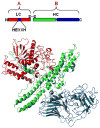

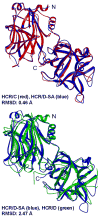
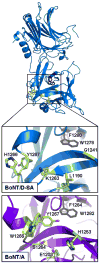
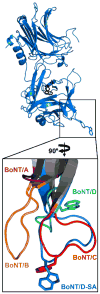
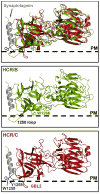
Similar articles
-
Identification of a unique ganglioside binding loop within botulinum neurotoxins C and D-SA.Biochemistry. 2010 Sep 21;49(37):8117-26. doi: 10.1021/bi100865f. Biochemistry. 2010. PMID: 20731382 Free PMC article.
-
Botulinum neurotoxin serotype C associates with dual ganglioside receptors to facilitate cell entry.J Biol Chem. 2012 Nov 23;287(48):40806-16. doi: 10.1074/jbc.M112.404244. Epub 2012 Oct 1. J Biol Chem. 2012. PMID: 23027864 Free PMC article.
-
Novel ganglioside-mediated entry of botulinum neurotoxin serotype D into neurons.J Biol Chem. 2011 Jul 29;286(30):26828-37. doi: 10.1074/jbc.M111.254086. Epub 2011 Jun 1. J Biol Chem. 2011. PMID: 21632541 Free PMC article.
-
Molecular structures and functional relationships in clostridial neurotoxins.FEBS J. 2011 Dec;278(23):4467-85. doi: 10.1111/j.1742-4658.2011.08183.x. Epub 2011 Jun 13. FEBS J. 2011. PMID: 21592305 Review.
-
Variations in the Botulinum Neurotoxin Binding Domain and the Potential for Novel Therapeutics.Toxins (Basel). 2018 Oct 20;10(10):421. doi: 10.3390/toxins10100421. Toxins (Basel). 2018. PMID: 30347838 Free PMC article. Review.
Cited by
-
Elucidation of the enigma of glycosphingolipids in the regulation of inflammation and degeneration - Great progress over the last 70 years.Proc Jpn Acad Ser B Phys Biol Sci. 2019;95(3):136-149. doi: 10.2183/pjab.95.011. Proc Jpn Acad Ser B Phys Biol Sci. 2019. PMID: 30853699 Free PMC article. Review.
-
Structural basis for the unique ganglioside and cell membrane recognition mechanism of botulinum neurotoxin DC.Nat Commun. 2017 Nov 21;8(1):1637. doi: 10.1038/s41467-017-01534-z. Nat Commun. 2017. PMID: 29158482 Free PMC article.
-
Retargeting the Clostridium botulinum C2 toxin to the neuronal cytosol.Sci Rep. 2016 Mar 30;6:23707. doi: 10.1038/srep23707. Sci Rep. 2016. PMID: 27025362 Free PMC article.
-
Botulinum neurotoxin X lacks potency in mice and in human neurons.mBio. 2024 Mar 13;15(3):e0310623. doi: 10.1128/mbio.03106-23. Epub 2024 Feb 13. mBio. 2024. PMID: 38347673 Free PMC article.
-
Characterization of a membrane binding loop leads to engineering botulinum neurotoxin B with improved therapeutic efficacy.PLoS Biol. 2020 Mar 17;18(3):e3000618. doi: 10.1371/journal.pbio.3000618. eCollection 2020 Mar. PLoS Biol. 2020. PMID: 32182233 Free PMC article.
References
-
- Singh BR, Gimenez JA, DasGupta BR. Comparative molecular topography of botulinum neurotoxins from Clostridium butyricum and Clostridium botulinum type E. Biochim Biophys Acta. 1991;1077:119–126. [pii] - PubMed
-
- Lacy DB, Tepp W, Cohen AC, DasGupta BR, Stevens RC. Crystal structure of botulinum neurotoxin type A and implications for toxicity. Nat Struct Mol Biol. 1998;5:898–902. - PubMed
Publication types
MeSH terms
Substances
Grants and funding
LinkOut - more resources
Full Text Sources
Other Literature Sources

